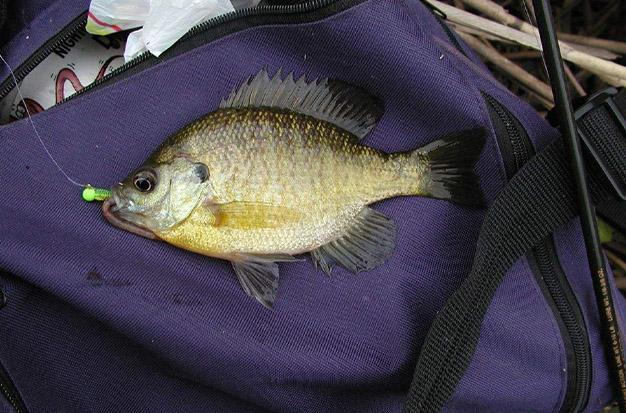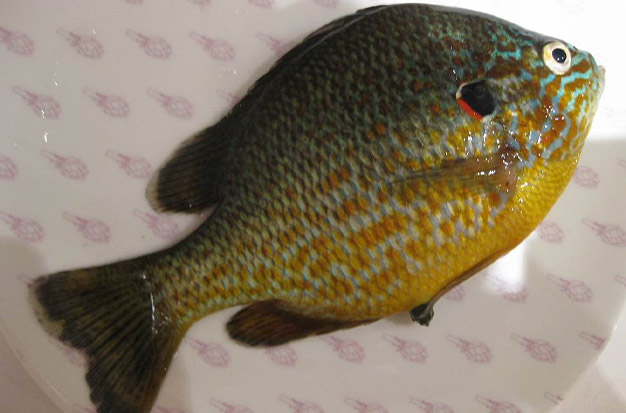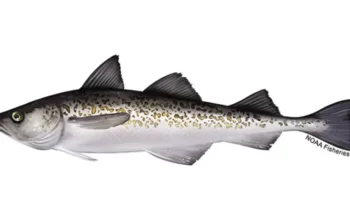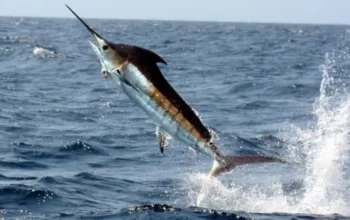Some of the most prevalent fish in North American waters include bluegill and other sunfish species. They can be caught using a variety of tackle and techniques in slow-moving rivers and streams, backwaters, weedy bays, and ponds.
Despite being relatively small—bluegill typically range in length from 4 to 8 inches—these fish can be a lot of fun to catch. In addition to being prized by many as delectable table fare, bluegill put up a valiant fight when fished with light tackle.
Bluegill are popular among novice and expert anglers alike due to their abundance, preference for shallow water, and eager readiness to bite.
Table of Contents
Bluegill Fishing Basics
The bluegill, Lepomis macrochirus, is a common panfish native to the It is particularly widespread east of the Rockies and can be found in just about any freshwater body of water, including small ponds, lakes, streams, creeks, and rivers as well as larger bodies of water.
There is a good chance that you will catch bluegill anywhere there is fresh water and a lot of aquatic vegetation.
Bluegill have flattened, slender bodies that are rounded behind the head and taper toward the tail. lengths of 6 to 8 inches are the most typical, with the typical range being 4 to 12 inches. The largest bluegill ever recorded weighed an astounding 4 pounds, 12 ounces, but they can grow up to 16 inches long! A fantastic food option is bluegill!
Bluegill can be easily recognized. They can have a wide range of scale color, but they all have a recognizable dark spot on the back of the gill plate. During the spawn, males’ bellies and breasts change from yellow-gold to a recognizable bright orange.
When To Fish Bluegill?
You can probably fish for bluegill throughout the year depending on where you live. The best bluegill fishing season, however, is during the spring and summer spawn, no matter where you are. The species will be in two to six feet of water at that time, usually covered. In a spawning bed, there may be up to 50 nests at once. The best time to strike is when the bluegill are grouped together in shallow water.
Bluegill can be found all year long in deeper waters, migrating in large schools after the spawning season is over.
Where To Catch Bluegill?
All across the country, bluegill and sunfish can be found in lakes, ponds, reservoirs, rivers, and streams. Usually, they favor calm or slowly moving water that warms up for at least part of the year. While many sunfish species, including bluegill, are now widely available in most states, the majority are native to regions east of the Rockies.
Even in Europe, where they are deemed invasive, bluegill have made it to some areas. However, almost every body of water in the United States can have sunfish, it’s still important to know where to look.
Sunfish Habitat
Sunfish almost always refer to a cover of some kind. That usually refers to aquatic vegetation. The edges of weed beds are frequently the best locations to find bluegill, but they also frequently gravitate toward other kinds of cover, such as submerged stumps and brush piles, downed trees, and rocky terrain.
The best spots are typically those that offer a variety of cover, such as a rocky drop-off that leads to a weed bed. Additionally, sunfish congregate around man-made structures, such as docks and piers, which they frequently use as cover and covert areas.
Catching Sunfish In Current
While bluegill and other species do inhabit rivers and streams, the majority of sunfish species do not thrive in current the same way they do in still water. Sunfish typically prefer areas of moving water where the current is weaker, such as deep holes, along banks, backwaters, and broad flats.
There is typically a good chance that sunfish will gather in areas where the current is lax enough to allow weeds to grow. In broad, lower river reaches as opposed to rushing, icy mountain streams, you’re more likely to find them.
Depth
Fish from shallow water are frequently thought of as sunfish. Somewhat, this is accurate. In just a few feet of water, particularly in the spring and summer, bluegill and other sunfish can frequently be found, but sunfish will also move between different depths based on the situation and the time of year.
During the hottest summer months, larger bluegill in particular frequently seek out water deeper than 10 feet, leaving their smaller relatives in the shallows.
In almost every lake or pond, the largest bluegill can frequently be found near a deeper weed bed that is close to a steep dropoff into shallower water.
How To Catch More Bluegill?
A number of factors make bluefish a sought-after species. They taste great, are widely available, and provide excellent sport. So, here are some bluegill fishing tips to help you increase your catch rates.
- Experiment at overlooked spots like small streams and rivers
- Use a clear line so the fish can’t see it
- Retrieve your cast line slowly and steadily

Bait Fishing For Bluegill And Sunfish
The most straightforward strategy for catching bluegill and other sunfish is typically live bait fishing. In fact, it’s frequently the best approach as well.
Types Of Live Bait For Bluegill And Sunfish
It’s a great way to introduce younger generations to fishing because many of us learned how to catch bluegill and sunfish with live bait when we were young. The following are a few of the most popular bluegill lures:
Nightcrawlers
When readily available, these relatively large worms—often 6 inches or larger—are among the most popular sunfish baits. The majority of fishermen cut them into tiny pieces and thread one or two of the smaller segments of nightcrawler onto a tiny bait hook.
Larvae Baits
In their natural habitat, sunfish typically consume tiny morsels, making larvae baits like mealworms, waxworms, and grubs very effective. They are the most popular bait for ice fishermen and are also effective in warmer water.
Red Worms
Red worms and nightcrawlers differ primarily in size; red worms are typically no longer than 2 or 3 inches, which makes them small enough to be used whole to catch bluegill. They are frequently referred to as red wigglers, and panfish find them hard to resist due to their active lifestyle.
Crickets
As sunfish bait, many fishermen swear by crickets. The crickets should be lightly hooked through the thorax with a small hook in the summer when they are most effective in order to keep them alive and moving. You can fish with them floating on the water’s surface or sunk for deeper fish.
Live Bait Fishing Techniques
Live bait fishing techniques for bluegill and sunfish come in countless varieties, but the majority fall into one of two groups: bottom fishing and bobber fishing.
Being open to both strategies is crucial. Simply let the environment (as well as the fish’s behavior) influence how you proceed.
Bottom Fishing
A split-shot rig, which involves securing one or two tiny split-shot sinkers to your line 6 to 12 inches above the bait, and a drop-shot rig, which involves securing a bell sinker to the end of your line typically 12 inches below the bait, are two common variations of bottom fishing for sunfish.
Bobber Fishing
This includes any methods that require you to attach a bobber or float to your line in order to keep the bait suspended above the surface. When fishing around weeds or other structures and avoiding snags, bobber fishing is particularly effective because it makes it simple to spot bites when the bobber moves or vanishes.
You can easily alter the distance between the bait and bobber depending on the situation, such as when you’re fishing over a weed bed.
Seven Tricks To Catch Bluegill
Even though no tip can ensure success, these seven tips are a good place to start!
Go Small With Fishing Hooks
Because they are fearless hunters, bluegill easily start biting. However, because of their tiny mouths, you’ll need to make your hooks and lures smaller if you want them to take them.
For live bait, teeny crankbaits from Fovonon, and extremely small topwater lures like Heddon’s Teeny Torpedo, I suggest using a size 6 hook.
You’ll catch fish whether you’re using a topwater or a crankbait if you keep the hooks small and the lures under two inches.
Also, No Products Found are what we like. in the 1/80 – 1/16 ounce range paired with tiny soft baits like those from Double Catch.
Soft baits with scents that are perfectly sized for bluegill are available from Double Catch.
Give Bluegills The Slip
The number of anglers I am aware of who didn’t begin their career by hooking panfish beneath a bobber can be counted on one hand. You’ll probably see a lot of fishermen throwing them into the shallows if you visit your neighborhood pond this summer.
Bluegill can also be killed with tiny bobbers holding a number 6 hook, as can other varieties of panfish. Bobbers do their jobs, without a doubt!
However, when compared directly to slip floats, they do have some significant drawbacks.
The biggest benefit of slip floats is that they don’t obstruct casting. They stay out of your way when you cast by using a movable knot aptly referred to as a float or bobber stop, which allows you to work from a distance that won’t frighten wary bluegills.
Check out our guide detailing the various types of fishing bobbers!
The Thill Crappie Cork is the only slip float that I enjoy more than it. They work equally well on bluegill and papermouth bass and come in a variety of weights to match your micro jigs and tiny hooks.
I’ve used many slip floats over the years, but Thill’s are the best.
They come pre-attached with a string stop and have a spring that enables fixed rigging for shallow water. There is no need for a bead on this float because the aperture is so small.
You’ll need a few float stops for the different seasons, and Tinky Fishing’s Rubber Float Stoppers are among our favorites. With the Thill’s tiny aperture, they work perfectly, and they’re also very easy to apply to your line.
Slow Down And Descend Your Lure
Bluegill will retreat from the shore of larger lakes in search of water that is cooler and more oxygenated. When that occurs, you’ll be looking for bluegill in the water column, where they may be as shallow as a few feet or as deep as 25 feet or so.
The larger “gills” will occasionally hold below their smaller relatives, forming a multi-layered school.
To give these predators some time to respond, it pays to slow the descent of your lure. Avoid the bottomless pit: lighten up on your jig heads, and give the bluegill time to notice!
In nature, most food is dispersed gradually through the water column, as Steve Ryan explains. By doing this, the object becomes visible to fish as it descends to the bottom and gives them a chance to find and access it. Bluegills in the area frequently pass over a bait that falls too quickly.”
Crickets Are King
If there is a better live bait than a kicking cricket given the bluegill’s natural diet, please let me know!
Live crickets are the best option when all other options have failed and you really need a sure bite!
Check out these results if you’re curious about how well this works:
You can watch this video to learn how to hook a live cricket if you’re still unsure of how to do it.
Dipping
In order to drop a lure into a small area, dipping uses a long rod, such as a 12″ B’n’M, or a cane pole. Getting too close to them with your boat can easily spook them because bluegill, like crappie, like to hold close to cover.
A cast, however, will simply not work in dense cover; instead, rely on reach.
The plan is to approach slowly, turn off your engine, and either use an anchor or a pole to stabilize your boat. When you’re this close to the action, trolling motors won’t be much use to you!
Utilizing the pole’s or rod’s reach, drop the jig into a pocket between branches or under dense cover while holding the line in one hand. Another technique for dipping is to extend the line to the reel seat, flip the jig where it needs to be, and then repeat.
Any slab can be teased out for a bite with a gentle flick of the wrist!
Go Deep
It may be time to back off the shallows and run deep when it’s hot outside and you’re fishing a larger lake.
Bluegill can retreat to cooler temperatures and still breathe because deeper oxygen concentrations in larger bodies of water can often remain high. Furthermore, in these kinds of circumstances, setting a slip float to allow you to work deep—often below 10 feet—can be incredibly effective.
Shooting
When it’s hot outside, bluegill love to gather under docks where they can find cover from the sun and safety from opportunistic predators. The real brutes, however, frequently seek out the deeper pilings where you can’t reach them with a cast when the water is high and the dock is low, making them challenging targets to reach.
Shooting is the solution!
Grab your soft bait behind the hook with your left hand while holding an ultralight rod in your right hand, open the bail, and tighten the line with your right index finger. Your rod can be loaded like a bow by pulling back on the jig.
You can fling that jig like an arrow by simultaneously releasing your left hand and index finger! You can master skipping jigs into deep cover with a little bit of practice.
Conclusion
Bluegill are a spring and summertime tradition for me, giving me the chance to enjoy myself while exploring my roots.
I hope you share my sentiments or, if you’re new to fishing, that you get the chance to create some of your own memories with these tenacious little fish.
These suggestions and techniques have helped me, and if they do the same for you, please let us know.
Comment below if you’d like to!




